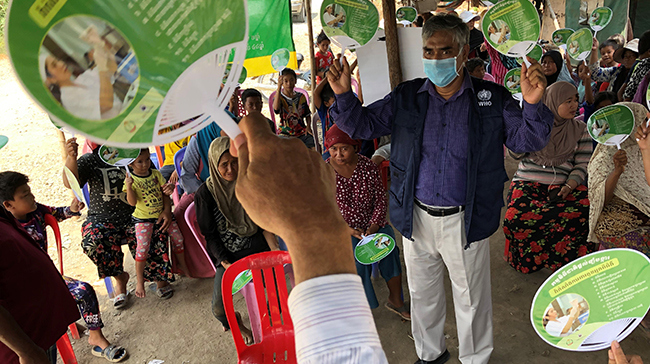
Why Engage?
Engaging with communities and other stakeholders allows you to work together to understand and address health-related issues. This starts with connecting – with community members, governments, health and other sectors, and any other relevant stakeholders. Building and strengthening these relationships and ongoing collaboration continues throughout each aspect of community engagement.
Key Questions to Consider
- In bringing communities and other stakeholders together, what issue(s) are we trying to better understand and address?
- What particular communities are we trying to reach and engage?
- Who can help in understanding and addressing the issue, and how can we reach and engage them?
- Have those who are directly affected by the issue been participating? If not fully, how can we better connect and support their participation?
- Have people who have responsibility or influence to change conditions been participating? If not fully, how can we connect and support their participation?
- How can each stakeholder be meaningfully engaged in each aspect of the work?
-
- Assessment
- Planning
- Action
- Evaluation
- Communication & Celebration
-
- Have we created an environment that encourages full and effective participation?
- What ground rules and guiding principles can help build trust and relationships among those involved?
- What strengths do those involved bring to the group (e.g. knowledge, skills, resources, networks)?
- What is the main purpose or function of the group? What group structure can support this purpose?
Some Recommended Actions
- __ Clarify the purpose for engaging with communities and other stakeholders.
- __ Identify those who need to be engaged, including those most affected and those who can address the issue.
- __ Reach out to those you want to engage through trusted people, organizations, and networks. (This may include local leaders or those with influence such as chiefs, elders, or faith-based leaders.)
- __ Communicate the need and benefits of taking action together.
- __ Make participation easy and rewarding. (This may include considerations for time, effort, cost, and location; ensuring respectful interactions; and making the experience rewarding.)
- __ Improve peoples’ abilities to be involved (e.g. provide information, skill training, technical support).
- __ Define the function and structure of the group (e.g. roles and responsibilities, coordination and leadership, communication and decision-making structures).
- __ Create an environment that fosters full and effective participation (e.g. welcoming, respectful, engaging quieter members).
- __ Establish shared ground rules and guiding principles to inform the group’s values, norms, and commitments for working together.
- __ Build and strengthen relationships and trust through respectful and responsive interactions.
Examples of Engagement
Building a community engagement network for a unified response to COVID-19 in Malaysia
Building community capacity to promote and protect mental health in Papua New Guinea
Resources to Help You Engage
Resources from the Community Tool Box
Toolkits
Creating and Maintaining Coalitions and Partnerships
Increasing Participation and Membership
Improving Organizational Management and Development
Troubleshooting Guides for Solving Common Problems
There is not enough community participation
There is no clear direction or communication with the group
Additional Resources (reading, tools, examples, and PowerPoints)
Chapter 6: Communications to Promote Interest
Chapter 7: Encouraging Involvement in Community Work
Chapter 9: Developing an Organizational Structure for the Initiative
Chapter 14: Core Functions in Leadership
Chapter 16: Group Facilitation and Problem-Solving
Chapter 20: Providing Information and Enhancing Skills
Chapter 27: Working Together for Racial Justice and Inclusion
-
- 27.1 Understanding Culture and Diversity in Building Relationships
- 27.2 Building Relationships with People from Different Cultures
- 27.6 Creating Opportunities for Members of Groups to Identify their Similarities, Differences and Assets
- 27.8 Multicultural Collaboration
- 27.9 Transforming Conflicts in Diverse Communities
- 27.10 Understanding Culture, Social Organization and Leadership to Enhance Engagement
Chapter 28: Spirituality and Community Building
-
- 28.1 Overview
- 28.2 Being Compassionate
- 28.9 Gratitude and Appreciation
Resources from WHO
Role of community engagement in situations of extensive community transmission of COVID-19 (WHO-WPRO)
Building on existing networks for community engagement in health emergencies (WHO-WPRO)
Actions for consideration in the care and protection of vulnerable population groups for COVID-19 (WHO-WPRO)
Risk communication and community engagement readiness and response to COVID-19 (WHO)
WHO community engagement framework for quality, people-centred and resilient health services (WHO)
Enhanced capacity building: Training for frontline staff on building trust and communication (WHO)
Understanding and managing fear: Training for humanitarian workers in emergencies (WHO)
Tips for engaging communities during COVID-19 in low-resource settings, remotely and in-person (GOARN RCCE Working Group)
COVID-19: How to include marginalized and vulnerable people in risk communications and community engagement (GOARN RCCE Working Group)
Community engagement and social mobilization (WHO)
Community participation in local heath and sustainable development – Approaches and Techniques (WHO)
Resources from Other Sources
Step-by-Step: Engaging Communities during COVID-19 (READY, USA)
An introduction to engagement (Book 1) (State Government of Victoria, Australia)
Community engagement for COVID-19 IPC: A rapid review of the evidence (Community Health – Community of Practice)
